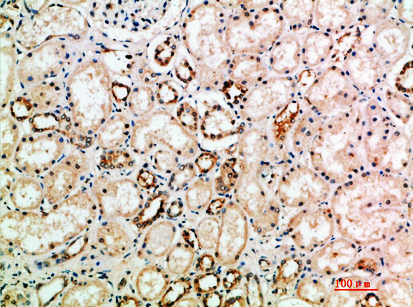NT-3 Polyclonal Antibody
- Catalog No.:YT5911
- Applications:IHC;IF;ELISA
- Reactivity:Human;Mouse;Rat
- Target:
- NT-3
- Fields:
- >>MAPK signaling pathway;>>Ras signaling pathway;>>PI3K-Akt signaling pathway;>>Neurotrophin signaling pathway
- Gene Name:
- NTF3
- Protein Name:
- Neurotrophin-3 (NT-3) (HDNF) (Nerve growth factor 2) (NGF-2) (Neurotrophic factor)
- Human Gene Id:
- 4908
- Human Swiss Prot No:
- P20783
- Mouse Gene Id:
- 18205
- Mouse Swiss Prot No:
- P20181
- Rat Swiss Prot No:
- P18280
- Immunogen:
- Synthetic peptide from human protein at AA range: 180-230
- Specificity:
- The antibody detects endogenous NT-3
- Formulation:
- Liquid in PBS containing 50% glycerol, 0.5% BSA and 0.02% sodium azide.
- Source:
- Polyclonal, Rabbit,IgG
- Dilution:
- IHC 1:50-200, ELISA 1:10000-20000. IF 1:50-200
- Purification:
- The antibody was affinity-purified from rabbit antiserum by affinity-chromatography using epitope-specific immunogen.
- Concentration:
- 1 mg/ml
- Storage Stability:
- -15°C to -25°C/1 year(Do not lower than -25°C)
- Other Name:
- Neurotrophin-3 (NT-3;HDNF;Nerve growth factor 2;NGF-2;Neurotrophic factor)
- Background:
- The protein encoded by this gene is a member of the neurotrophin family, that controls survival and differentiation of mammalian neurons. This protein is closely related to both nerve growth factor and brain-derived neurotrophic factor. It may be involved in the maintenance of the adult nervous system, and may affect development of neurons in the embryo when it is expressed in human placenta. NTF3-deficient mice generated by gene targeting display severe movement defects of the limbs. The mature peptide of this protein is identical in all mammals examined including human, pig, rat and mouse. [provided by RefSeq, Jul 2008],
- Function:
- function:Seems to promotes the survival of visceral and proprioceptive sensory neurons.,polymorphism:Variant Glu-76 (frequently reported as Glu-63) was thought to be associated with severe forms of schizophrenia. This does not seem to be the case.,similarity:Belongs to the NGF-beta family.,tissue specificity:Brain and peripheral tissues.,
- Subcellular Location:
- Secreted.
- Expression:
- Brain and peripheral tissues.
Zhen-qiao, L. I. U., C. H. E. N. Qing-qing, and W. A. N. G. Yu-rong. "Effect of medium frequency electrical stimulation on expression of neurotrophin-3 in rat masseter muscle." JOURNAL OF SHANGHAI JIAOTONG UNIVERSITY (MEDICAL SCIENCE) 40.05 (2020): 604.
- June 19-2018
- WESTERN IMMUNOBLOTTING PROTOCOL
- June 19-2018
- IMMUNOHISTOCHEMISTRY-PARAFFIN PROTOCOL
- June 19-2018
- IMMUNOFLUORESCENCE PROTOCOL
- September 08-2020
- FLOW-CYTOMEYRT-PROTOCOL
- May 20-2022
- Cell-Based ELISA│解您多样本WB检测之困扰
- July 13-2018
- CELL-BASED-ELISA-PROTOCOL-FOR-ACETYL-PROTEIN
- July 13-2018
- CELL-BASED-ELISA-PROTOCOL-FOR-PHOSPHO-PROTEIN
- July 13-2018
- Antibody-FAQs
- Products Images

- Immunohistochemical analysis of paraffin-embedded human-kidney, antibody was diluted at 1:200



